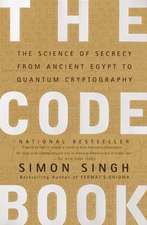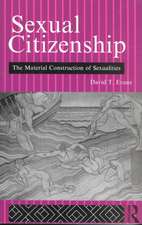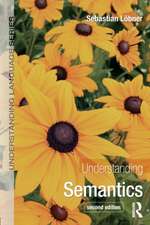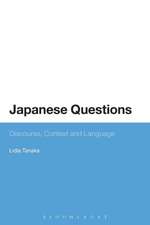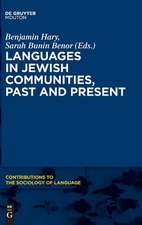Language and Identity: Discourse in the World
Editat de David Evansen Limba Engleză Paperback – 29 iun 2016
| Toate formatele și edițiile | Preț | Express |
|---|---|---|
| Paperback (1) | 257.32 lei 6-8 săpt. | |
| Bloomsbury Publishing – 29 iun 2016 | 257.32 lei 6-8 săpt. | |
| Hardback (1) | 773.88 lei 6-8 săpt. | |
| Bloomsbury Publishing – 17 dec 2014 | 773.88 lei 6-8 săpt. |
Preț: 257.32 lei
Preț vechi: 331.10 lei
-22% Nou
Puncte Express: 386
Preț estimativ în valută:
49.24€ • 51.22$ • 40.65£
49.24€ • 51.22$ • 40.65£
Carte tipărită la comandă
Livrare economică 14-28 aprilie
Preluare comenzi: 021 569.72.76
Specificații
ISBN-13: 9781474294942
ISBN-10: 1474294944
Pagini: 256
Dimensiuni: 156 x 234 x 13 mm
Greutate: 0.35 kg
Ediția:NIPPOD
Editura: Bloomsbury Publishing
Colecția Bloomsbury Academic
Locul publicării:London, United Kingdom
ISBN-10: 1474294944
Pagini: 256
Dimensiuni: 156 x 234 x 13 mm
Greutate: 0.35 kg
Ediția:NIPPOD
Editura: Bloomsbury Publishing
Colecția Bloomsbury Academic
Locul publicării:London, United Kingdom
Caracteristici
Uncovers the power within and behind discourse - the ability to colonize smaller discourses
Notă biografică
David Evans is a Fellow in Education in the Education Faculty at Liverpool Hope University, UK
Cuprins
Part 1 Theoretical Overview1. Introduction David Evans 2. The Identities of Language David Evans 3. How Language Shapes Social Perception Philippe Chassy Part 2 Languages, Discourses and Identities in the World4. Quebec's Shift from Ethnic to Civic National Identity: Implications for Language Attitudes Amongst Immigrants in Montreal Ruth Kircher 5. Trilingualism and Uyghur Identity in the People's Republic of China Mamtimyn Sunuodula, Anwei Feng and Bob Adamson 6. 'Queensland for Ever & Augus un ballybug go braugh': The Expression of Identity in Nineteenth-Century Irish Emigrant Letters Marije van Hattum 7. Indigenous Languages, Cultures and Communities in the Amazon: Strengthening Identities Alex Guilherme Part 3 Critical Pedagogies8. The Language of Leisure and Physicality: Constructing and Re-constructing Identity Wendy Bignold9. Drama and the Identity of the Language Learner Bernie Hughes 10. Towards a Cultural Paradigm of Alterity in Modern Foreign Language (MFL) Learning David Evans 11. English Language Teacher Identity: A Framework for Teacher Learning and Professional Development Richard Kiely 12. ConclusionIndex
Recenzii
In this three-part collection ... David Evans and other contributors explore the interrelationships between language and identity with a particular focus on how language shapes the social discourse and pedagogy of minority ethno-linguistic communities ... [A] valuable resource for students and researchers in the areas of sociolinguistics, language acquisition, and communication.
This book is brought together by its authors' fascinating discussions of culture ... [Part 1] provides a useful overview of core theoretical concepts explaining the relationship between language and identity. Part 2 delivers an accessible and very interesting account of the sociolinguistics of globalisation and multilingualism, whilst those hoping to learn more about the relationship between identity and second-language learning will certainly benefit from the chapters in Part 3.
This volume has synthesized and compiled a diversified body of research supported by accessible writing styles ... A valuable reference for readers in anthropological linguistics, sociolinguistics, and discourse analysis, especially those engaging with topics related to linguistic and cultural minorities.
[This] publication with its wide scope of topics and its vast range including highly theoretical articles as well as decidedly practice-oriented ones, represents an informative book for all those who are interested in the language learner and the language teacher, and the identities they adopt in the (different) process(es) of language acquisition ... The editor's and the authors' courage to tackle it anew is a justified - and successful - attempt to give it new impulses and new research orientations.
While language conveys information it does much more than that; it shapes the very information it conveys. It also shapes and reflects identities. Language determines how people see themselves and how they are seen by others. Language can both create identity and well as constrain it. This important book gives voice to linguistic and cultural minorities. It contains an inspiring range of discussions of how communities can navigate their way between languages and cultures and how, by adopting a critical pedagogy, people can revitalize and develop self-esteem and pride in their identities.
This book is brought together by its authors' fascinating discussions of culture ... [Part 1] provides a useful overview of core theoretical concepts explaining the relationship between language and identity. Part 2 delivers an accessible and very interesting account of the sociolinguistics of globalisation and multilingualism, whilst those hoping to learn more about the relationship between identity and second-language learning will certainly benefit from the chapters in Part 3.
This volume has synthesized and compiled a diversified body of research supported by accessible writing styles ... A valuable reference for readers in anthropological linguistics, sociolinguistics, and discourse analysis, especially those engaging with topics related to linguistic and cultural minorities.
[This] publication with its wide scope of topics and its vast range including highly theoretical articles as well as decidedly practice-oriented ones, represents an informative book for all those who are interested in the language learner and the language teacher, and the identities they adopt in the (different) process(es) of language acquisition ... The editor's and the authors' courage to tackle it anew is a justified - and successful - attempt to give it new impulses and new research orientations.
While language conveys information it does much more than that; it shapes the very information it conveys. It also shapes and reflects identities. Language determines how people see themselves and how they are seen by others. Language can both create identity and well as constrain it. This important book gives voice to linguistic and cultural minorities. It contains an inspiring range of discussions of how communities can navigate their way between languages and cultures and how, by adopting a critical pedagogy, people can revitalize and develop self-esteem and pride in their identities.




